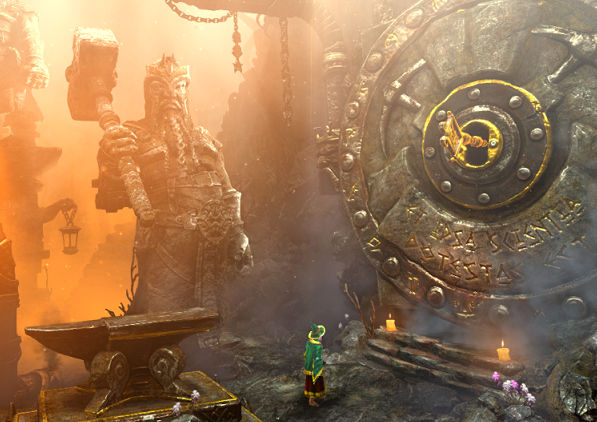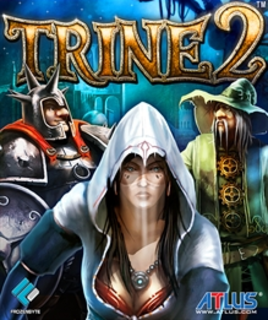FOREWORD:
This review is about the Goblin Menace and Dwarven Caverns DLC, which appear to offer a puzzle-platforming experience and aesthetics which are different from those in the original package. They are actually part of the “Complete Story” edition too, but research on the inclusion of the DLC in this edition does not yield anything which suggests that they have been changed for the sake of this edition.
PREMISE:
Throughout the story of the original adventure of Trine 2, there were goblins, the reason for the presence of whom was not particularly well elaborated. The expansions for Trine 2 will provide this reason, and more besides, especially on the lore behind the fantastical world of the Trine games.
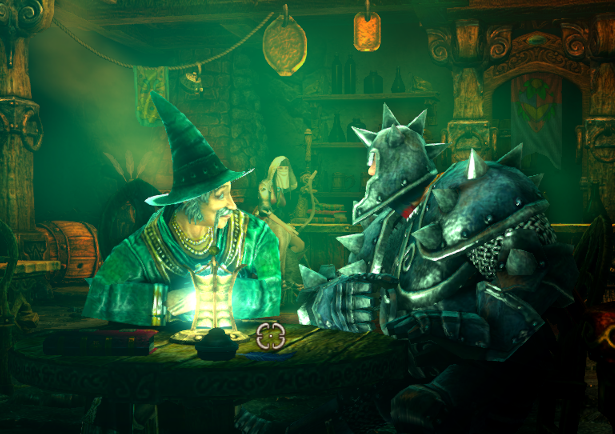
After the conclusion of the original adventure, the trio of protagonists returns to their home city, only to find it curiously deserted. Apparently, they were not aware that the city was about to be put under siege by an unexpectedly well-armed and –equipped army of goblins. Apparently, the goblins which were seen in the warped forests of the original adventure are actually the vanguard of the army.
Threatening the wife of the wizard Amadeus, Wheeze the goblin chieftain tricked the trio into being marooned on a faraway land. Ever mysterious, the Trine is curiously silent on their ordeal (and the rather distraught Amadeus, in particular).
Soon enough, the trio gets caught up in more trouble – trouble which is a lot less visually charming than those in the original adventure, though no less astounding.
MORE DANGEROUS PUZZLES & OBSTACLES:
What sets the puzzle-based challenges in the DLC apart from those in the original adventure is their difficulty. Some elaborative examples will be cited.
There were swinging pendulums in the original adventure. However, those ended with flails which while painful, are not immediately fatal when they do hit the player characters; they could even be used for puzzle solutions. In the DLC adventures, the pendulums are generally ended with fast-moving, sharp and massive blades, which outright kill any player character whom they hit.
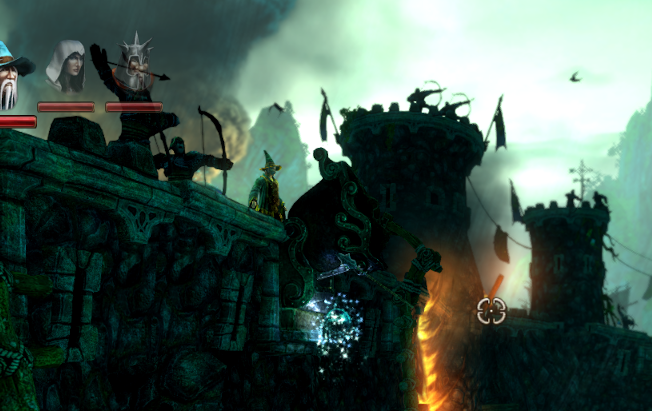
The chasms in the DLC are also substantially longer, either requiring greater swings with Zoya’s grappling hook or Pontius’s charging and floating powers (both of which must be purchased). (Some chasms can also be overcome with composite bridges which are made using Amadeus’s magnet spell – which also has to be purchased.)
Newer hazards include pervasive darkness, which is encountered within a specific, very fleshy stage. The player will discover that all of the three protagonists’ abilities, while colourful, do not double well as light sources. Instead, the player will need to observe and learn about using light sources which are built into/grown from the environment.
The DLC also includes incredibly unstable platforms, which can, fortunately, be manipulated by Amadeus (although it is not immediately clear how this is so).
WIDER DISTANCES BETWEEN CHECKPOINTS:
Indeed, there is a lot less room for error when negotiating the hazards and puzzles in Trine 2. One false step and the player loses a character outright. In the original adventure, this would not have been a problem because the number of checkpoints where characters can be revived is very generous (relatively speaking).
In the DLC adventures, they are sparse. This change can seem like a cheesy way of increasing the difficulty.
MORE USES FOR ZOYA’S AND PONTIUS’S SKILLS:
In the original adventure, Amadeus does most of the puzzle-solving work; this is something that he even remarked about. In the DLC, the player has to use Zoya and Pontius more often.
To cite some examples for Pontius, Pontius’s charge skill is needed in order to jump across long chasms. Pontius’s hammer throw is also the only way to reach breakable stuff which is underwater.
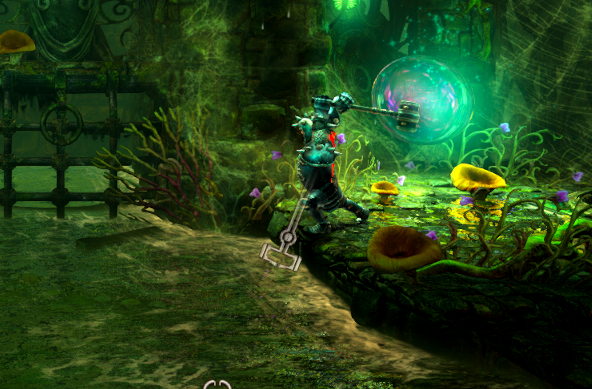
As for Zoya, the player will find that Zoya’s anti-gravity arrow is indispensable for obstacles and puzzles where the player characters must jump very high. In addition, the player will need to learn about how this ability of Zoya synergizes with those of Amadeus and Pontius.
This greater utility for Zoya and Pontius is much appreciated. Yet, a skeptical player may notice that many of the puzzles/obstacles which necessitate their abilities have been specifically designed with them in mind. In the original adventure, most puzzles and obstacles can be overcome in more than one way, including the usual haphazard stacks of boxes which Amadeus can make. In the DLC, Zoya’s or Pontius’s abilities must be used, many times.
NEW ENEMIES:
The DLC adventures throw some new enemies at the protagonists, in addition to many returning ones. Among these, there is the goblin cannoneer, who epitomizes how technologically advanced the goblins are. There are also mummies of the undead sort; these are shambling monsters who can take a tremendous beating.

Nevertheless, the bulk of the enemies in the DLC adventures are goblins. Even for the “secret” level that is the Dwarven Caverns, the goblins are still the main antagonists.
Perhaps the most entertainment value to be had from the enemies in the DLC adventures is their presence in the levels and the presentation of the levels. For example, some levels appear to suggest that the goblins once had a homeland, though it was destroyed and turned barren by a massive subterranean creature, thus suggesting that their invasive activities against human settlement is a forceful migration of sort.
VISUAL DESIGNS:
If the preceding screenshots do not show already, the DLC adventures now include cutscenes which show very close views of the character models; closer than even those in the original adventure of Trine 2.
Jaded players might consider these models to have too much minute detail in lieu of more nuanced designs though; for one, the facial animations of the characters are rather lacking, especially considering the amount of effort which has been invested in details such as the patterns on the trim of Amadeus’s hat. Likewise, lip-synching is quite sparse (or completely non-existent, in the case of the veiled Zoya).
Still, the cutscenes do serve their purpose, which is the development of the characters. Amadeus, in particular, appears to have more of the limelight than the other two protagonists. To describe more would be to include spoilers, of course.
The environments in the original adventure differed from those in the first Trine by being a bit more foreboding; after all, cursed enchanted forests are more ominous than regular enchanted forests. Following a trend of sorts, the environs in the DLC adventures for Trine 2 are also different in theme and tone.
To cite some examples, the player will be shown a city under a thunderous siege, which is quickly followed by the desolated ruins of a lost civilization. This is then followed by the startlingly disgusting guts of a giant animal, which is perhaps the greatest visual divergence from what the Trine series has done up to then.

Nevertheless, if Frozenbyte’s goal for introducing such visual designs is to show that it is artistically versatile, then it has achieved its goal in a spectacular manner.
SOUND DESIGNS:
The DLC adventures also differ from the original adventure with regard to the number of lines which characters utter. The protagonists speak a lot more in the DLC, further expressing the personalities which they have established from the first game and the original adventure of the second. There is also a lot more banter this time around, though the kind of humour to be expected remains the same, e.g. Amadeus is still skittish, Zoya is still avaricious and Pontius is ever the culinary enthusiast.
CONCLUSION:
On their own, the DLC packages would not have been worth much, especially to a skeptical player. The different puzzles and obstacles which they offer would have been more appreciable if they had been part of the main package in the first place. However, as part of the “Complete Story” edition, they provide a different change of pace from the easier challenges in the original adventure, though not always convincingly for the better.
